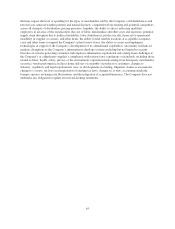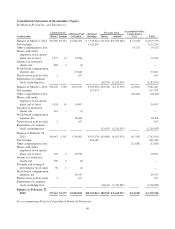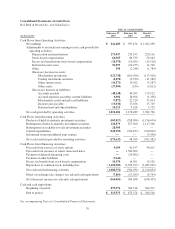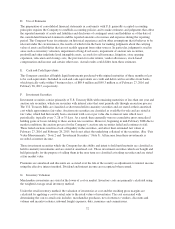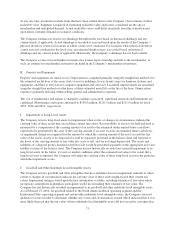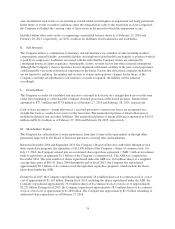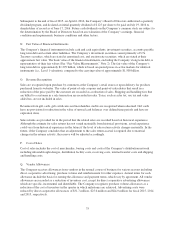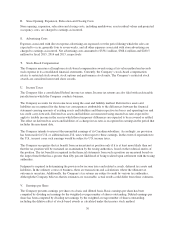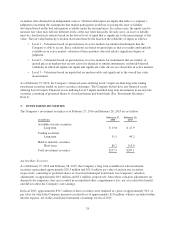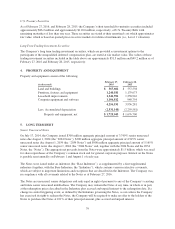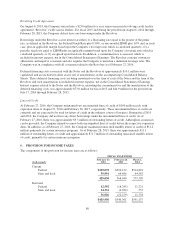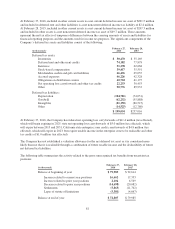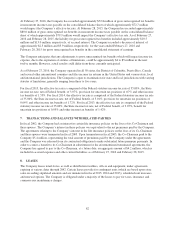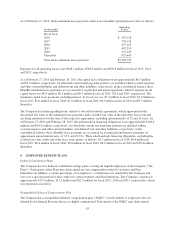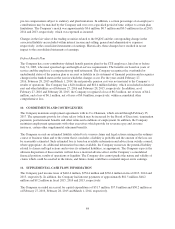Bed, Bath and Beyond 2015 Annual Report Download - page 87
Download and view the complete annual report
Please find page 87 of the 2015 Bed, Bath and Beyond annual report below. You can navigate through the pages in the report by either clicking on the pages listed below, or by using the keyword search tool below to find specific information within the annual report.Subsequent to the end of fiscal 2015, on April 6, 2016, the Company’s Board of Directors authorized a quarterly
dividend program, and declared an initial quarterly dividend of $.125 per share to be paid on July 19, 2016 to
shareholders of record as of June 17, 2016. Future cash dividends on the Company’s common stock are subject to
the determination by the Board of Directors based on an evaluation of the Company’s earnings, financial
condition and requirements, business conditions and other factors.
N. Fair Value of Financial Instruments
The Company’s financial instruments include cash and cash equivalents, investment securities, accounts payable,
long term debt and certain other liabilities. The Company’s investment securities consist primarily of U.S.
Treasury securities, which are stated at amortized cost, and auction rate securities, which are stated at their
approximate fair value. The book value of the financial instruments, excluding the Company’s long term debt, is
representative of their fair values (See “Fair Value Measurements,” Note 2). The fair value of the Company’s
long term debt is approximately $1.299 billion, which is based on quoted prices in active markets for identical
instruments (i.e., Level 1 valuation), compared to the carrying value of approximately $1.500 billion.
O. Revenue Recognition
Sales are recognized upon purchase by customers at the Company’s retail stores or upon delivery for products
purchased from its websites. The value of point-of-sale coupons and point-of-sale rebates that result in a
reduction of the price paid by the customer are recorded as a reduction of sales. Shipping and handling fees that
are billed to a customer in a sale transaction are recorded in sales. Taxes, such as sales tax, use tax and value
added tax, are not included in sales.
Revenues from gift cards, gift certificates and merchandise credits are recognized when redeemed. Gift cards
have no provisions for reduction in the value of unused card balances over defined time periods and have no
expiration dates.
Sales returns are provided for in the period that the related sales are recorded based on historical experience.
Although the estimate for sales returns has not varied materially from historical provisions, actual experience
could vary from historical experience in the future if the level of sales return activity changes materially. In the
future, if the Company concludes that an adjustment to the sales return accrual is required due to material
changes in the returns activity, the reserve will be adjusted accordingly.
P. Cost of Sales
Cost of sales includes the cost of merchandise, buying costs and costs of the Company’s distribution network
including inbound freight charges, distribution facility costs, receiving costs, internal transfer costs and shipping
and handling costs.
Q. Vendor Allowances
The Company receives allowances from vendors in the normal course of business for various reasons including
direct cooperative advertising, purchase volume and reimbursement for other expenses. Annual terms for each
allowance include the basis for earning the allowance and payment terms, which vary by agreement. All vendor
allowances are recorded as a reduction of inventory cost, except for direct cooperative advertising allowances
which are specific, incremental and identifiable. The Company recognizes purchase volume allowances as a
reduction of the cost of inventory in the quarter in which milestones are achieved. Advertising costs were
reduced by direct cooperative allowances of $31.7 million, $25.6 million and $24.0 million for fiscal 2015, 2014
and 2013, respectively.
75


